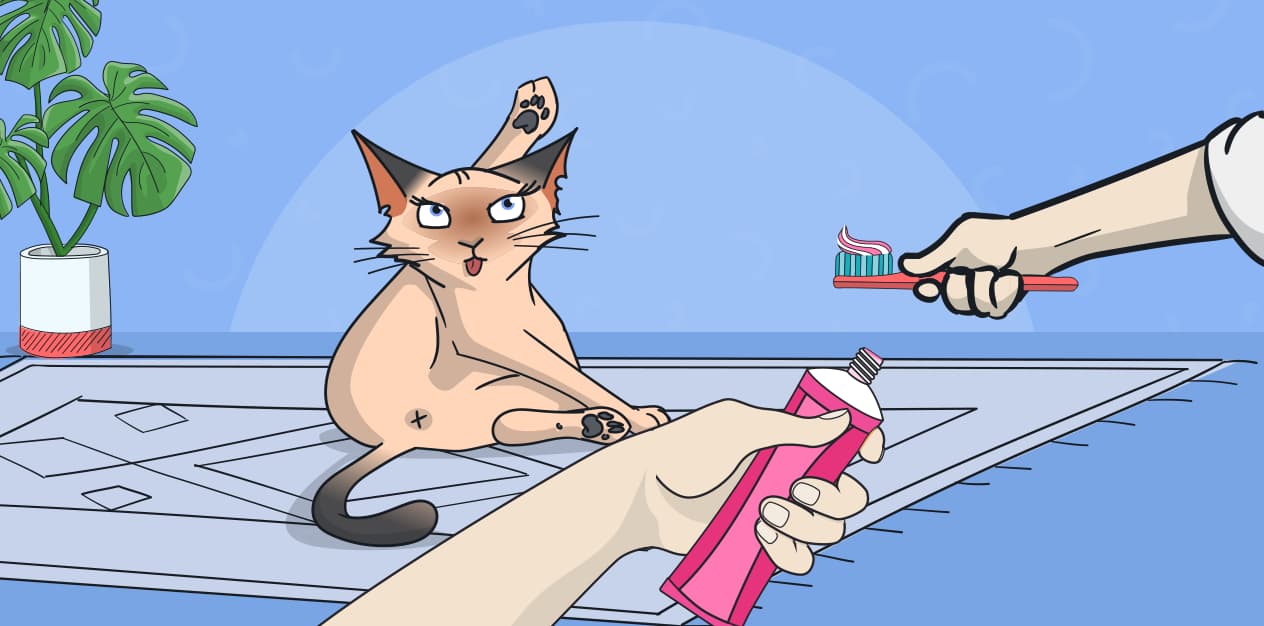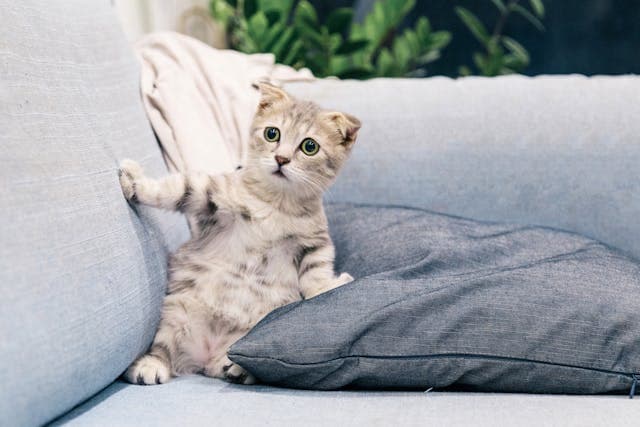

 Back
Back
Cat Dental Health: A Complete Guide
Cats may groom themselves and act like Miss Independent, but they need help with their teeth just like the rest of us. Dental health is extremely important to ensure cats live a long, happy life. Their teeth need to be taken care of to prevent bad breath and other forms of cat dental diseases.

Writer Jannah Berkley

All about cat teeth
We may not meow or go nuts for catnip, but cat teeth are a lot like our own. Cats also have two sets of teeth in their lifetime: milk teeth and adult teeth. Kittens have 26 little teeth, while adult cats usually have around 30 full-grown teeth.
Kittens are often born without teeth and start to show their first incisors (front teeth) within the third or fourth week of life. The rest of their baby teeth and premolars follow soon after. These milk teeth last only a few weeks and tend to fall out around the 11th week. Unfortunately, don’t call the kitty tooth fairy just yet, as she may not find any baby teeth – they’re so small that many kittens simply swallow them.
A cat’s permanent teeth start growing when they’re around 16 weeks old and keep growing until they’re around 7 months old. All told, they end up with a set of 30 teeth—incisors, canines, premolars, and molars.
Like humans, each type of tooth has an important function. The 12 incisors (at the front of the cat’s mouth) cut their food into smaller chunks, bite toys, or lightly chomp on your hand when playing. The 4 canine teeth (framing the incisors) help them hold onto food and defend themselves. The 10 premolars (towards the back of the mouth) help them break down their food. And way in the back, their molars help them chew hard substances.
Dental health routine
As a loving pet parent, there are plenty of things you can do to keep your cat (and their teeth) happy:
- Feed them a balanced diet
- Give them dental treats
- Brush their teeth with cat tooth gel or toothpaste (as often as they’ll let you!)
- Schedule regular check-ups with your vet
- Check for bad breath
The American Animal Hospital Association recommends that kittens and adult cats should have a full oral examination as soon as possible (after birth or adoption). Your cat may have slow-to-erupt teeth, overlapping teeth, or an abnormal jaw length. Checking your kitten or young cat can already tell you so much about their tooth health and what’s to come.
It’s recommended that before your cat turns five, they get a true dental prophylaxis, which is a common procedure done under anesthesia. It includes a full teeth cleaning, complete oral examination, and removal of plaque and build-up above and beneath the gum line.

Cat dental diseases
As cats age, their teeth are prone to certain diseases. Studies show that the majority of cats older than four suffer from some type of dental disease. If your cat’s teeth begin to become diseased, they’ll tend to stop eating altogether, which causes a slew of other health issues. With that being said, these diseases are mostly preventable with proper care.
There are three main dental diseases to look out for: gingivitis, periodontitis, and tooth resorption.
Gingivitis
What is it?
This is a condition when the gums become inflamed, swollen, red, and painful. It comes from plaque buildup between the teeth and gums.
How to spot it
If your cat’s gums have any redness, swelling, or bleeding, this may be a sign. Your cat also may start drooling, stop eating, or have bad breath. If you see them strangely moving their head while eating or only going for soft foods, this may also be a tell.
Prevention
Brushing your cat’s teeth is the best way to avoid plaque build-up and prevent gingivitis.
Treatment
Luckily, in most cases, gingivitis is reversible. Depending on how severe the case is, your vet will recommend the relevant treatment. This could be cleaning your cat’s teeth at home, prescribing antibiotics, removing the deep plaque (under anesthesia), prescribing immunosuppressive drugs, or in the worst case, removing teeth that are too inflamed.
Periodontitis
What is it?
Periodontitis mostly happens when gingivitis goes untreated. Bacteria destroys the tissue that attaches the tooth to the bone and may cause loose teeth or tooth loss.
How to spot it
It has the same clinical signs as gingivitis – redness, swelling, bleeding, bad breath, and strange chewing habits. If it’s advanced, you may be able to see the roots of your cat’s teeth and their teeth may be loose.
Prevention
The same as gingivitis, brushing your cat’s teeth regularly is the best way to avoid plaque build-up and prevent periodontitis.
Treatment
Your vet can completely remove the plaque by scaling the teeth. To do this, your cat will be under anesthesia. If the disease has progressed beyond that, they may need to remove some of the teeth.
Tooth resorption
What is it?
Tooth resorption is when the tooth breaks down from the inside out. It’s the most common reason that cats lose teeth.
How to spot it
It creates pinkish discoloration where the gum meets the tooth. It’s painful, so your cat may refuse to eat, drool, chew in a strange new way, or be very angry around feeding time.
Prevention
Brush, brush, brush the teeth!
Treatment
Your vet will start by trying to manage the pain. If the problem has spread into the crown of your cat’s tooth, the vet will recommend removing it.
You can do so much for your cat by simply brushing their teeth at home. However, no home routine is foolproof. Before you find yourself out of pocket on dental damage, get a quote from Animalia and learn more about cat health insurance and the dental health add-on.





We offer the most comprehensive coverage
out there
Having Animalia is like a top-of-the-line
Rolls-Royce with a swimming
pool in the trunk.



Get your pet insurance quote
Is your pet a...
- Dog
- Cat
What is your pet's name?
Zip code





